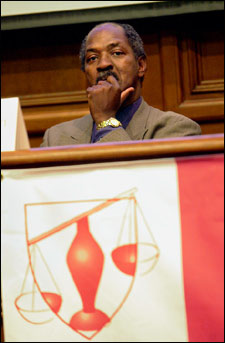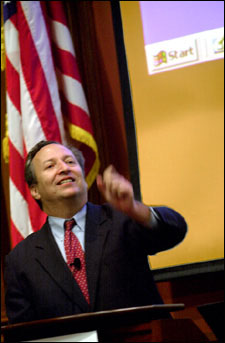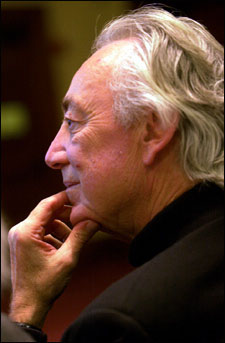Internet conference examines Harvard’s digital identity:
Berkman Center looks at Harvard’s image from within, without

From the failed promise of flying vehicles to the very real presence of virtual tours on the Internet, Harvard administrators, faculty, and information technology professionals examined the impact of technology on Harvard’s digital identity at a Harvard Law School conference last week.
The two-day Internet and Society Conference 2002, “What is Harvard’s Digital Identity?” drew faculty, administrators, and IT professionals from across the University to the Law School’s Austin Hall. Sponsored by the Berkman Center for Internet & Society, discussions featured Harvard President Lawrence H. Summers, Provost Steven Hyman, several deans, faculty, and key administrators.
The conference touched on everything from Harvard’s brand on the Internet to uses of the Internet both within and outside Harvard.
Charles Ogletree, Jesse Climenko Professor of Law and conference co-chair, said that this year’s conference, the fourth since 1996, would turn the focus inward where other conferences looked at such external issues as the impact the Internet would have on rich and poor. The internal focus would examine, through the lens of technology, Harvard’s impact on the world and the world’s view of Harvard.
“This year we reach deeper, wider and higher by exploring Harvard’s digital identity,” Ogletree said.
Ogletree said Harvard is in a good position to be a leader in the digital world. The University has a massive information technology presence, sending hundreds of thousands of e-mail messages a day, purchasing 15,000 personal computers per year, and serving a student body most of whom have cell phones, land-line phones, laptops, and at least one other digital device.

Even with all the ease of communication and access to information that the digital age gives, however, Ogletree said something appears to be missing, and figuring out what and why is one of the conference’s missions. People today, he said, “spend more, but have less,” “buy more but enjoy it less” and have “added years to life, but not life to years.”
In the opening keynote speech on Friday (Nov. 15), Summers presented his own vision of a technological future where traditional classrooms – augmented by an enhanced use of technology in education – are still the primary way people learn.
One area in which the information technology revolution will have a large impact, he predicted, will be in the community of international scholars. There, he said, access to the Internet can make a huge difference in bringing the latest information to scholars around the world, particularly those who used to wait months for the latest journals and scientific articles to arrive. He predicted that the wider dissemination of knowledge will help speed the development of new ideas.
But Summers, offering an example from the past, also said that no one can truly predict for sure where technology will take education, if it takes it anyplace at all. He quoted Harvard President Nathan Pusey in 1958, talking about the potential of educational television in words that echo many predictions about the Internet today.
“I’ve read about how new technologies offer the prospect of university faculty reaching a far wider audience than they ever had before, reducing the tyranny of time and place, by making it possible to listen to lectures at a different time than when a lecture is given and a different place than where a lecture is given. Now, this creates the potential to change the nature of the university by allowing them [faculty] to disseminate knowledge far more widely than they ever had in the past,” Summers said, then added. “It didn’t happen.”
The Internet has undoubtedly already impacted how some faculty teach their classes – and how students learn. A panel examining use of the Internet within Harvard, moderated by Provost Hyman, Harvard College Professor and Maria Moors Cabot Professor of Biology Richard Losick, Akira Yamaguchi Professor of Environmental Health and Human Habitation John Spengler, and Harvard Business School Chief Information Officer Judy Stahl presented examples of how the Internet directly impacts today’s students.

Losick said his molecular biology teaching has been transformed completely over the years, with the course Web site now a central resource for students. There, he said, students can find videotapes of his lectures, a forum where they can ask questions, links to important resources including scientific journals, and animations that illustrate important molecular processes.
“Technology is transforming teaching,” Losick said. “The Internet has become an adjunct to the course and transformed how I teach introductory molecular biology.”
Like Losick, Stahl said Harvard Business School is trying to figure out ways to augment classroom teaching. One thing they’ve done is to create Web-based tutorials that help students learn basic terms, techniques, and skills, such as how to use Excel software. She gave as an example an online game in which students have one hour to build an investment portfolio within certain parameters. The experience of doing it themselves, Stahl said, gives students a much greater understanding of the difficulty of such a task than they would get from a paper case study.
“By having this exercise incorporated in the case, students got a much better learning experience than they would have [with the case alone],” Stahl said.
Though the Internet was broadly seen to be adding to, rather than substituting for, classroom learning, Harvard’s Division of Continuing Education has been experimenting more and more with distance learning where the Internet is the primary means of learning.
Spengler, who teaches environmental management at the Harvard Extension School, said this semester about 80 students attend the class each week. Another 30, however, are taking the course online. Those students hail from five continents, including Africa.
“This has been a very exciting aspect of our course,” Spengler said.
The class is also experimenting with virtual tours, which take students to the Deer Island waste treatment plant, to Cape Cod’s beaches, and to Superfund sites. Spengler said they’ve developed software and hardware to make producing these types of tours easy and have encouraged graduate students to employ the equipment in their projects. That way, Spengler said, their work is not lost, but rather provides a foundation for further exploration. The virtual tour tools can not only be used to preserve knowledge created at Harvard, but can also bring information on innovative projects outside Harvard into the classroom, for consumption by Harvard students.
“With this electronic ability, we can make the world our classroom,” Spengler said. “We can break down barriers and integrate the knowledge of the world into our learning.”




